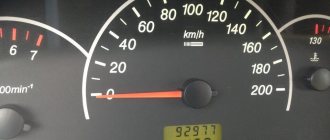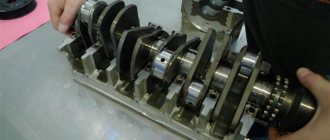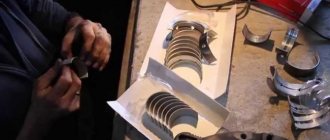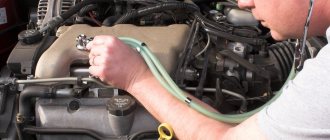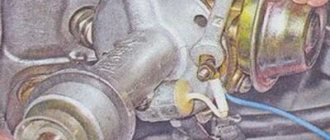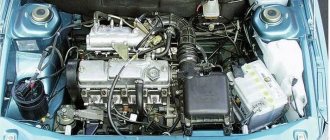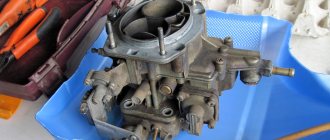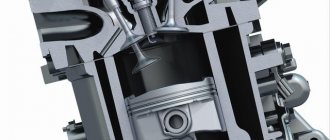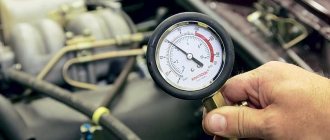Operating principle of radio tape recorders
Car radios have long been an integral part of any car. Even such options as the UAZ Patriot and VAZ 2110-2114 are no exception. The operating principle of any car radio is almost the same and does not depend on the model. When the driver gets into his car and turns on the ignition, all systems are automatically started, including multimedia. Next, the starter is engaged to start the engine. At the same time, the instrument lighting dims, and the radio turns off when the engine starts. When the engine starts, the multimedia system starts working normally again.
It is believed that one of the reasons for this behavior of the radio is that the engine is still cold after starting. As soon as the engine warms up, the radio will not turn off when restarted. The starter is involved in the process of starting the car. It consumes a large amount of electrical energy - at the moment of starting a cold engine, the voltage in the car’s on-board network drops significantly and the radio is simply not enough.
Why does it turn off?
When the voltage in the on-board network when starting the engine drops below the set limit, the car radio turns off.
When starting the engine, the front panel of the receiver goes out for a while, and after turning off the starter and starting the engine, it lights up again and the operation of the device resumes. There are several reasons why the car radio turns off when you start the engine.
Protective function of the radio
This mechanism is built into some car players. Protection is applied to prevent disruption of the functionality of the device. The fact is that strong voltage surges when operating at high volumes can lead to settings failure or failure of the radio due to burnout of microcircuits. Thanks to the protection, the head unit does not turn off when the engine is started, but only reboots. All settings set by the user remain the same.
The car radio's protection function will work if the battery voltage drops when starting the engine due to insufficient charge or freezing temperature.
Insufficient battery capacity that does not correspond to the parameters of the vehicle also leads to the radio turning off.
Constant shutdown of the head unit occurs due to problems in the ignition switch if the power connection is made through it. This phenomenon is caused by the occurrence of a strong voltage drop across worn or dirty contacts.
Radio protection system
For the driver, the main goal is to start the engines. Support for any other devices is relegated to the background. All the energy available in the battery is used to operate the starter. The radio does not have enough power and turns off. Many car enthusiasts are very nervous about this, but this is not a minus, but a plus. If the radio turns off when you start the engine, then the voltage is low, and the device, especially of Chinese origin, may not work correctly. To prevent serious failures in the circuitry or software, the system automatically turns off - this is how protective mechanisms work.
When the car has already driven a certain distance and the engine has been turned off, when you try to start it again, the radio will not turn off. The amount of energy increased due to the battery being recharged by the generator.
Manufacturers also took these points into account: most radio tape recorders have a so-called threshold for triggering protective functions. The condition of the battery must be taken into account.
Reasons for radio loss
First of all, car owners begin to check the power cable. As a rule, it is routed on the left side of the driver, and the interconnect wires are routed on the right side. The speaker wiring, located on the left side of the car, is routed along with the power cable and radio antenna.
And indeed, if you mess up the connection of interconnect wires in the connectors, then noise and interference cannot be avoided.
Often the problem is caused by the subwoofer. If it is de-energized, everything returns to normal.
No exception is the power supply of the head unit. Again, incorrect connection of the speaker system. As a rule, the power cable should go to the amplifier separately, and the other power cable should go to the power unit separately, with the obligatory insertion of a fuse near the battery. And, of course, the car radio should be grounded to prevent interference.
If everything is fine with the wiring and interconnects, doubt automatically falls on the amplifier. It is quite possible that the rulers on the sound amplification device have burned out. It will help to check the installation of a known-good amplifier. If the noise disappears, then the only thing left to do is buy and install a new amplifier.
Connecting the radio
One of the reasons why the radio turns off when the engine starts may be the connection, or rather the diagram of how to do it correctly.
If you connect a multimedia device in series according to the circuit proposed by the manufacturer, then when you start the engine and turn the key from On to Start at the ignition switch, a power interruption occurs.
This problem can be solved by powering the multimedia device directly from the battery. However, there are disadvantages to this connection: the radio will drain the battery. On a cold winter night, the radio can be enough to completely drain the battery.
Reasons for radio loss
First of all, car owners begin to check the power cable. As a rule, it is routed on the left side of the driver, and the interconnect wires are routed on the right side. The speaker wiring, located on the left side of the car, is routed along with the power cable and radio antenna.
And indeed, if you mess up the connection of interconnect wires in the connectors, then noise and interference cannot be avoided.
Often the problem is caused by the subwoofer. If it is de-energized, everything returns to normal.
No exception is the power supply of the head unit. Again, incorrect connection of the speaker system. As a rule, the power cable should go to the amplifier separately, and the other power cable should go to the power unit separately, with the obligatory insertion of a fuse near the battery. And, of course, the car radio should be grounded to prevent interference.
Current leaks in the on-board network
If the radio turns off when starting the car, then the problem may lie in so-called current leaks. That is, when the ignition is turned off, there are consumers that discharge the battery. Overnight, due to these leaks, the battery can completely die. In order to solve the problem, you need to detect the leak and find its culprit. It can also be a radio, alarm, central locking and other systems.
Wires
This is another reason if the radio turns off when you start the engine. It could be all about the wires. Radio tape recorders are often connected with thin, low-quality wires. They have insufficient characteristics and multimedia is unstable.
A solution to the problem may be to replace the power cables of the radio with copper analogues with a cross-section of 2.5 mm. This allows you to completely forget about rebooting and turning off the radio. Also, the music does not turn off when the volume is increased. This method can be used to prevent the radio from turning off when starting, but it will only work normally with a relatively new battery.
Solutions and tips
To determine whether a car radio is defective, you should remove it from the car and take it to a service center that repairs audio equipment. If a fault is discovered that cannot be repaired, you will have to buy a new device. Speakers with a voice coil impedance of less than 4 ohms should not be used. This will sooner or later lead to failure of the audio system due to overheating and burnout of the power amplifier chip.
To identify and fix speaker problems, you should check your speaker cables for twisted, frayed, or damaged wires. If extensive defects are found, the entire wiring should be changed. You can do this yourself or at a car service that specializes in car audio.
When connecting connectors, you must ensure that the leads do not come into contact with the speaker housings to prevent a short circuit.
To solve problems with overvoltage protection, you can install an additional amplifier or replace the audio device with a more powerful one.
To eliminate the power shortage, you should reconnect the car radio to the on-board network. Wires with a thickness of at least 0.75 mm should be used. The more powerful the device, the thicker the wire. The most reliable connection of the negative pole is carried out as follows.
A stud is found under the instrument panel, which is cleaned of paint, dust, dirt and oil. Then take a piece of wire with a “chip” that has a hole of a suitable diameter. One end is connected to the radio, the chip is put on a pin and screwed tightly with a nut and a spring washer. The positive wire connects directly to the car battery. The connection made in this way will be the most reliable. This especially applies to powerful radios, as well as active subwoofers (with an amplifier).
Starter
Sometimes the battery may have nothing to do with it, and the problem may be hidden in the starter. During the operation of the latter, its parts are subject to wear. If the starter bushings are worn out, the shaft may get stuck in them and more energy must be spent to turn it. Hence the shutdown of most electrical consumers.
To correct this malfunction, an inspection of the starter is necessary. It is necessary to check the brushes, commutator, replace worn bushings, and lubricate the mechanisms. After such a revision, the starter will work like new, which means it will need less voltage.
Refinement of the radio
Car enthusiasts modify their radios themselves if they did not take this moment into account. To solve the problem, you will need 2 elements - a 22,000 microfarad capacitor with a voltage of 25 V, as well as a 10 A diode (the diode must be selected based on the fuse ratings in the radio). In this circuit, the diode will serve as a valve - it will not allow the capacitor to power the on-board system of the car, but will only power the radio.
The scheme is simple. A capacitor is soldered between the power wires of the radio. A diode is soldered onto the positive wire with the positive contact to the “+” of the capacitor.
Car radio overheating
Some car owners may experience overheating of the car radio. Usually this breakdown is detected in the summer. In this case, it is worth checking the cooling elements (radiators) on the back of the radio (where the wires are located). If they don’t work, and the entire back panel is hot, then you should look for the problem in the radiators.
Car radio
Most of the problems that cause the radio to turn on and off on its own are also related to other car systems, so you shouldn’t be indifferent to this problem, but fix it in a timely manner.
Club of Hyundai Sonata owners of all generations.
- Unanswered topics
- Active topics
- Search
- Users
- our team
Currently browsing this forum: no registered users and 5 guests
How it works?
So. When the driver starts the car, the starter takes on most of the voltage, so the radio turns off when the engine starts. To prevent the multimedia system from turning off, a diode and a capacitor are used.
The main supply voltage to the radio goes through the diode and charges the capacitor. When the ignition is turned on, voltage will flow through the diode and charge an additional capacitor. When the starter is operating, the voltage in the on-board network sags. The diodes do not allow the voltage in the capacitor to go into the network - all the charge will go to the radio, so that the radio does not turn off when the engine starts. To operate the latter for 5 seconds, a capacitor with a capacity of 470 uf is sufficient.
